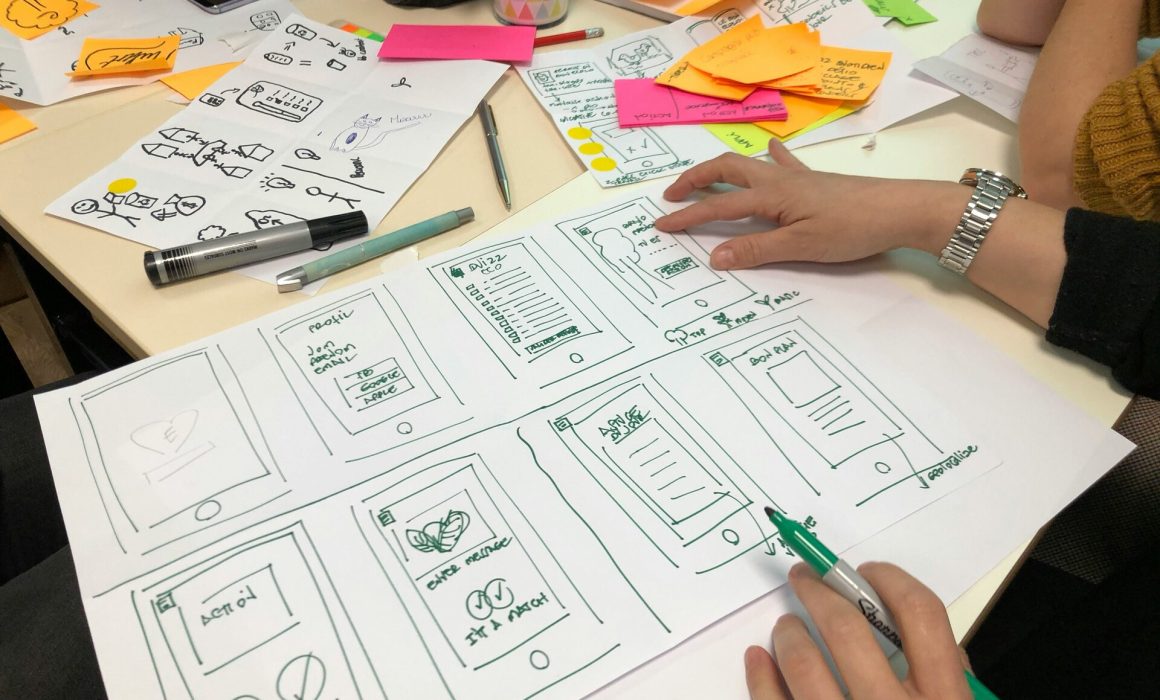Introduction to UI/UX design: definitions and core concepts
Welcome to the fascinating world of UI/UX design! In this post, we will delve into the fundamental concepts that form the backbone of user interface (UI) and user experience (UX) design. By understanding these core concepts, you’ll be equipped to navigate the intricacies of crafting captivating and user-centric digital experiences.
What is User Interface (UI) Design?
User Interface (UI) refers to the visual elements, interactive components, and overall aesthetics of a digital product. It’s what users see, touch, and interact with.
User Interface (UI) Design is the meticulous art of creating visually appealing and intuitive interfaces that users interact with. It encompasses a spectrum of elements such as layout, typography, color schemes, and interactive components. Think of it as the aesthetic facet of digital design, where form meets function to deliver an engaging visual experience.
To see UI design principles in action, explore the familiar interfaces of apps like Instagram, with its intuitive navigation and visually pleasing content arrangement.
What a UI Designer does
UI designers are the visual architects of digital products. They shape the aesthetics (look and feel) of digital products and interactive elements that users engage with, ensuring that every visual element aligns with the brand identity. Their primary responsibilities include:
1. Visual Design
UI Designers are responsible for creating visually appealing interfaces that align with the brand identity, evoke the desired emotions, and meet user expectations. Some tasks involved in visual design include:
- Picking out color palettes.
- Selecting the appropriate font families, sizes, styles, and other typography elements like line spacing, kerning, and letter spacing for a polished and consistent look.
- Designing and incorporating meaningful icons that visually represent actions, features, or concepts within the interface.
- Adding other visual elements like graphics, images, buttons, etc that contribute to the overall visual appeal.
- Establishing design patterns and standardized design language to provide consistency e.g. ensuring that similar actions or functions across the application have consistent visual representations.
2. Layout Design
UI Designers determine the arrangement and positioning of various elements on the screen to create an intuitive and visually pleasing layout. This involves tasks like:
- Arranging elements in an intuitive and aesthetically pleasing manner.
- Ensuring responsiveness (adaptability to different screen sizes).
3. Interactive Design
Adding interactive elements enhances user engagement and creates a more seamless UI. Examples include:
- Adding animations to page elements.
- Developing interactive components like buttons, sliders, and forms.
- Managing how elements move when users interact with them.
4. Branding Integration
Strategic incorporation of a brand’s visual elements into the user interface ensures that the product’s design aligns seamlessly with the brand’s identity and personality. This is crucial in maintaining consistency and establishing brand recognition. Branding integration includes:
- Defining brand style guides.
- Incorporating brand styles consistently across products.
- Ensuring the brand’s visual elements meet accessibility standards.
What is User Experience (UX) Design
User Experience (UX) encompasses the broader journey a user takes with a product – from their initial interaction to the final emotional response, as well as how easy it is for the user to accomplish their desired tasks.
UX Design transcends visual aesthetics. It is about crafting a delightful and satisfactory experience for users. Imagine ordering a product online—the ease of navigation, the simplicity of the checkout process, and the timely delivery—all contribute to a positive user experience.
What a UX designer does
A UX designer is the architect of the user’s journey. Their objective is to craft an experience that not only meets but exceeds user expectations, resulting in a positive and memorable interaction. Some of their responsibilities include:
1. User Research
UX designers conduct thorough research to understand the target audience, their behaviors, preferences, needs, and pain points. This involves:
- Carrying out surveys, interviews, and observational studies to understand user motivations.
- Analyzing data to derive insights that guide design decisions.
- Creating user personas to better empathize with users.
2. Wireframing and Prototyping
Wireframing: Developing low-fidelity representations of the user interface to outline the basic structure and layout. Wireframes illustrate the placement of elements without focusing too much on the visual details.
Prototyping: Building interactive models that simulate the functionality and flow of the final product. UX designers also conduct usability testing on prototypes to identify and address potential issues.
3. Information Architecture
UX designers are responsible for organizing and structuring information within products to create a logical flow that enhances navigation and comprehension. This includes:
- Creating site maps, user flows, and hierarchical structures.
- Mapping out step-by-step processes and interactions.
- Ensuring logical flows through various features and functionalities that align with user mental nodes.
4. Iterating Based on User Feedback
User-centricity remains the core focus of UI/UX. UX designers collect feedback from users throughout the design process to ensure proper alignment.
- Communicating user insights and findings with stakeholders.
- Iterating user feedback into design iterations.
- Prioritizing user needs in design discussions and decision-making.
- Making data-driven decisions to enhance the user experience over time.
5. Accessibility Considerations
Ensuring that a product is accessible for users with diverse abilities and disabilities is quintessential in design. UX designers achieve this by:
- Adhering to accessibility standards and guidelines.
- Conducting regular accessibility audits to identify and address potential barriers.
Differences Between UI and UX Designers
UI and UX designers often work closely together and as such, it is pretty common for both roles to be confused with one another. While there is some overlap between the two roles, there are some key differences to consider:
| Aspect | UI Designer | UX Designer |
|---|---|---|
| Focus | Visual aesthetics and the look of the interface | Overall user experience, including usability and functionality |
| Primary Concern | How the product looks | How the product works and how users interact with it |
| Tools | Adobe XD, Sketch, Figma | Axure RP, Balsamiq, Adobe XD |
| Activities | Designing interactive elements, layouts, and visual aspects | User research, wireframing, prototyping, and usability testing |
| Output | High-fidelity visual designs and prototypes | Wireframes, prototypes, user personas, and user flows |
| Role in the Process | Works closely with UX designers to implement visual design | Collaborates with UI designers and other team members to ensure a seamless user experience |
| Goal | Create visually appealing interfaces | Ensure a positive and efficient overall user experience |
What it takes to succeed as a UI/UX designer
To succeed as a UI/UX designer, a combination of both hard skills (technical and practical skills) and soft skills (interpersonal and personal attributes) is crucial.
Soft Skills
Success in UI/UX design requires a blend of essential soft skills:
- Communication: Effectively conveying design concepts to diverse stakeholders.
- Empathy: Understanding and empathizing with user needs and tailoring designs for a better experience.
- Collaboration: Working seamlessly with cross-functional teams to bring designs to life.
- Problem-solving: Creative problem-solving skills to address design challenges.
- Adaptability: Flexibility to adapt to changing project requirements and design trends.
- Attention to Detail: Meticulousness in design execution for a polished final product.
- Time Management: Efficiently managing time and priorities to meet project deadlines.
- Continuous Learning: Keeping up with industry trends, new tools, and evolving design methodologies.
- Client/Customer Focus: Prioritizing the needs and expectations of clients or end-users.
- User-Centered Design Thinking: Applying design thinking principles, including ideation, prototyping, and iteration, with a focus on the user.
Hard Skills
Mastering essential hard skills sets a designer apart:
- Visual Design: Ability to create visually appealing designs using tools such as Adobe XD, Sketch, Figma, or Adobe Creative Suite.
- Wireframing and Prototyping: Skill in sketching wireframes and building interactive prototypes, utilizing tools like Balsamiq, Axure RP, InVision, or Proto.io.
- User Research: Conducting thorough research to inform design decisions.
- Information Architecture: Proficiency in organizing and structuring information through techniques like site maps, user flows, and content hierarchies.
- Typography and Color Theory: Understanding of font styles, sizes, and color palettes to craft visually pleasing and coherent designs.
- Usability Testing: Capability to plan, conduct, and analyze usability tests to gather valuable insights for design improvements.
- Responsive Design: Knowledge of responsive design principles, ensuring interfaces work seamlessly across various devices and screen sizes.
- Coding Skills (Optional): Basic familiarity with HTML, CSS, and JavaScript can facilitate effective collaboration with development teams.
- Prototyping Tools: Proficient use of Figma, InVision, or Adobe XD to create high-fidelity prototypes for user testing and development handoff.
Jobs in UI/UX Design
The demand for UI/UX designers has led to various roles, including:
- UI Designer: Crafts visually appealing interfaces, and collaborates with graphic designers and developers.
- UX Designer: Shapes the overall user experience, conducts research, creates wireframes, and tests designs.
- Interaction Designer: Focuses on user interactions within the interface to enhance usability.
- UI/UX Designer (Generalist): Combines both UI and UX responsibilities, involving creating visually appealing interfaces while also considering the overall user experience.
- Information Architect: Structures and organizes information within a product, creating site maps, user flows, and content hierarchies to enhance user navigation.
- Usability Analyst: Analyzes the usability of a product through testing and research, providing insights to improve the overall user experience.
- UX Researcher: Conducts in-depth user research, gathers insights, and creates user personas to inform design decisions and improve the product.
- Product Designer: Takes a holistic approach, considering both the UI and UX aspects along with the product’s overall strategy and business goals.
- Mobile App Designer: Specializes in designing interfaces specifically tailored for mobile applications, considering the constraints and opportunities of mobile platforms.
- Web Designer: Focuses on designing user interfaces for websites, considering factors such as responsiveness and cross-browser compatibility.
- Visual Designer: Primarily focuses on the visual aspects of design, including layout, color, and typography, to create visually compelling and coherent designs.
- User Interface Developer (UI Developer): Implements the UI design into code, collaborating closely with designers to ensure the visual elements are accurately translated into the final product.
- User Experience Strategist: Develops strategies for enhancing the overall user experience, considering user needs, business goals, and market trends.
- Service Designer: Designs end-to-end service experiences, considering multiple touchpoints and interactions within a broader service ecosystem.
- AR/VR UX Designer: Specializes in creating user experiences for augmented reality (AR) and virtual reality (VR) applications, considering unique challenges and opportunities in immersive environments.
The specific responsibilities may vary based on the organization, industry, and project requirements.
There are many entry points to a career in UI/UX. You can initiate your journey through freelancing, constructing a portfolio showcasing your skills for prospective employers. Alternatively, you can opt to collaborate with established UX/UI design teams within your current workplace to cultivate the necessary skills for a career transition. Acquiring hands-on experience and assembling a compelling body of work can undoubtedly set you apart in the competitive job market.
Quiz
- What is the primary focus of UI design?
- Usability
- Visual elements
- Information Architecture
- User research
- Which task is primarily associated with UX designers?
- Creating brand style guides
- Designing interactive elements
- Conducting usability testing
- Choosing color schemes
- Why is adaptability considered a crucial soft skill for UI/UX designers?
- It helps in wireframing and prototyping.
- It allows for effective communication.
- It facilitates collaboration with cross-functional teams.
- It enables designers to embrace changes and stay updated.
Answers
- Visual Elements
- Conducting usability testing
- It enables designers to embrace changes and stay updated.
Practical Application and Assignment
This assignment serves as a practical bridge between theory and application.
- To do:
- Analyze the UI/UX aspects of a familiar digital product (app or website).
- Identify aspects that enhance or hinder the user experience.
- Propose actionable recommendations to improve the overall design and user interaction.
- Considerations:
- Reflect on the role of UI in maintaining brand consistency and the impact of UX on the overall user journey.
- Apply principles discussed in the chapter, considering both soft and hard skills.
More Resources to Explore
- Nielsen Norman Group
- Smashing Magazine
- UX Design Portfolio: Best Practices
- Inclusive Design Principles
- User Experience Basics
- Web Style Guide
- Material design
- Behance
- Dribbble
Next Steps: Becoming a Design Expert
Congratulations on completing this immersive introduction! Establish a disciplined daily study routine, engage with the design community, and envision yourself evolving into a UI/UX design expert. Remember to check out other posts within the series and follow up daily to strengthen your skills, laying the foundation for success in the ever-evolving world of design.


